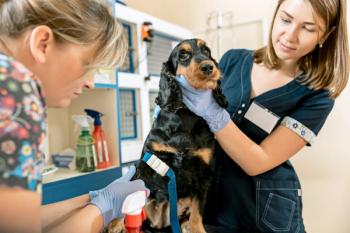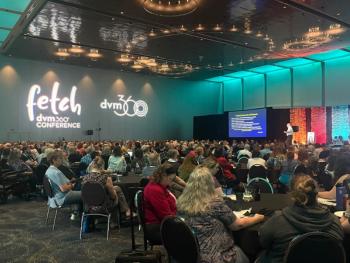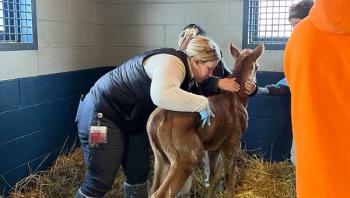
CVMA clashes on RVT licenture expansion
Sacramento, Calif. - New powers proposed for registered veterinary technicians (RVTs) have the California Veterinary Medical Assocation (CVMA) squarely opposed.
SACRAMENTO, CALIF. — New powers proposed for registered veterinary technicians (RVTs) have the California Veterinary Medical Assocation (CVMA) squarely opposed.
Dr. Eric Weigand
If passed at a Jan. 25 licensing board hearing, California would rank as the first state to grant RVT's authorization to incise the skin for placement of intravascular catheters, among other procedures. The meausre's language also calls for requiring an RVT license to administer IV chemotherapy drugs as well as anesthesia by January 2011.
Proponents of the expansion measure cite the new RVT job tasks as a means for increasing earning potential, which could translate to higher retention, recruitment and career satisfaction rates. The state's "chronic" shortage of RVTs is rooted in lack of pay, recognition and advancement as well as competition with unregistered assistants, the California Veterinary Medical Board's (CVMB) Registered Veterinary Technician Committee (RVTC) says.
CVMA vows to fight. Its leaders paint the move as dangerous. While association representatives plan to take issue with the job tasks expansion during the public hearing, they lack the power to stop a vote by the licensing board. CVMA President Dr. Eric Weigand contends the proposal goes "too far."
"Every definition of surgery starts with incision, and that's the job of a veterinarian," he says. "This is not good for California consumers and especially not good for the veterinary profession. If this anesthesia language passes, you can bet we'll have a crisis on our hands by 2011."
Domino effect
The fallout Weigand predicts involves owners forced to scramble for more RVTs when supply is low, and demand likely will cause salaries to skyrocket, he says. According to CVMA figures, 3,556 RVTs are licensed in California, with many assumed to work for universities and drug companies in the state. That means a shortage for California's 7,093 resident DVMs.
"RVTs are tough to find almost anywhere," says Weigand, owner of a small animal practice in Claremont, Calif. "My registered technician isn't here all hours of operation. If this passes, it will make services less available and more expensive to the consumer. It will make referral oncology practices a nightmare to maintain."
Sue Geranen
Proficiency also is a concern considering programs are variable. "A license does not ensure competency, and that's a big issue," Weigand adds.
Promoting career advancement
At issue for Dr. Richard Johnson is CVMA's alleged unwillingness to legitimize RVTs. As chair of the licensing board's RVT task force committee, Johnson notes the group's year-and-a-half commitment to developing the new rules and holds the CVMA responsible for not addressing retention long ago. The owner of a 13-doctor practice in San Diego says California is the only state in the country that designates differences between unlicensed and licensed technicians using only four job tasks: application of casts and splints, anesthesia induction by inhalation or intravenous injection, suturing of existing skin incisions and dental extractions.
"Why become an RVT if you're not doing anything different from people off the street?" Johnson asks. "We need to allow them to do procedures outside of cleaning cages and holding dogs. Unless we give something else a try, we're just maintaining the status quo. We're losing our technicians."
To Johnson and other expansion supporters, opening that door means eventually allowing technicians into the realm of diagnosing, prescribing and minor surgery — duties physician assistants in California can perform.
"Even a nurse can do an episiotomy for birthing," Johnson says. "There is a model out there. Yet veterinarians say we can't hire at the level of physician assistants. Why not? What has the veterinary profession in the state of California done to promote trained technical staff? I can't think of anything."
Backing change
While it would be ideal to have RVTs educated to the level of physician assistants, that's not current reality, Weigand says.
"The training would have to be dramatically different," he says. "It's like apples and oranges."
Accredited RVT training is a two-year program consisting of 60 educational units of classroom instruction. All registered veterinary technicians must pass a standardized exam for licensure, and the American Veterinary Medical Association's (AVMA) Council on Education accredits just 10 of California's 12 RVT programs. By contrast, physician assistants, established in the 1960s to address a shortage of primary care physicians, complete roughly 26 months of training before sitting for licensure.
Sue Geranen admits there are instructive differences, yet she says a slow transformation is possible. The CVMB executive director says association leaders are "resisting growth" among RVTs, which as a profession hasn't changed for almost 30 years.
"The CVMA has objections about allowing RVTs to make nick incisions to put in catheters, and they're upset about new anesthesia requirements," she says. "But where is the consumer protection of these tasks if you don't regulate who can do them?"
Wrong path
The addition of job tasks isn't how RVTs should take advantage of a "huge vacuum" that Weigand claims is now evident in the profession.
While new veterinary graduates historically have filled the roll of glorified technician, hefty student loans requiring higher starting salaries have forced owners to demand their immediate performance as practitioners. That leaves a hole for technicians to fill using their current level of training.
"What has changed in veterinary job duties in the last 100 years? Nothing," he says. "But look how much the profession's changed. The same thing can happen for technicians if they're leveraged correctly."
Newsletter
From exam room tips to practice management insights, get trusted veterinary news delivered straight to your inbox—subscribe to dvm360.




